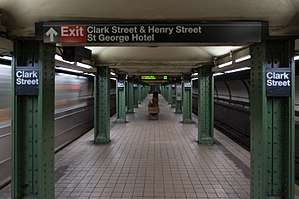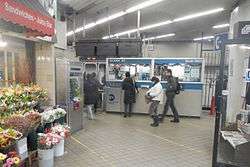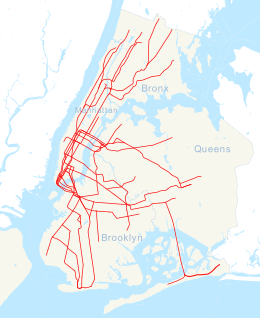Clark Street station
Clark Street is a station on the IRT Broadway–Seventh Avenue Line of the New York City Subway. It is located at Clark Street and Henry Street in Brooklyn Heights, Brooklyn. It is served by the 2 train at all times and the 3 train at all times except late nights.
Clark Street | |||||||||||||
|---|---|---|---|---|---|---|---|---|---|---|---|---|---|
 Platform level | |||||||||||||
| Station statistics | |||||||||||||
| Address | Clark Street & Henry Street Brooklyn, NY 11201 | ||||||||||||
| Borough | Brooklyn | ||||||||||||
| Locale | Brooklyn Heights | ||||||||||||
| Coordinates | 40.6974°N 73.9931°W | ||||||||||||
| Division | A (IRT) | ||||||||||||
| Line | IRT Broadway–Seventh Avenue Line | ||||||||||||
| Services | 2 3 | ||||||||||||
| Structure | Underground | ||||||||||||
| Platforms | 1 island platform | ||||||||||||
| Tracks | 2 | ||||||||||||
| Other information | |||||||||||||
| Opened | April 15, 1919 | ||||||||||||
| Station code | 334[1] | ||||||||||||
| Accessible | |||||||||||||
| Wireless service | |||||||||||||
| Opposite-direction transfer available | Yes | ||||||||||||
| Former/other names | Clark Street–Brooklyn Heights | ||||||||||||
| Traffic | |||||||||||||
| Passengers (2019) | 1,781,419[3] | ||||||||||||
| Rank | 259 out of 424[3] | ||||||||||||
| Station succession | |||||||||||||
| Next north | Wall Street: 2 | ||||||||||||
| Next south | Borough Hall: 2 | ||||||||||||
| |||||||||||||
| |||||||||||||
| |||||||||||||
History
On April 15, 1919, the Clark Street Tunnel opened, and this station opened with it, extending West Side Line express trains from Wall Street on the other side of the East River to Atlantic Avenue via a new connection at Borough Hall. The connection doubled the capacity between Manhattan and Brooklyn and eased congestion from the Joralemon Street Tunnel. Direct express service to Times Square was provided to the inhabitants of Brooklyn for the first time as a result.[4]
During the 1964–1965 fiscal year, the platforms at Clark Street, along with those at four other stations on the Broadway–Seventh Avenue Line, were lengthened to 525 feet to accommodate a ten-car train of 51-foot IRT cars.[5]
In 1981, the Metropolitan Transportation Authority (MTA) listed the station among the 69 most deteriorated stations in the subway system.[6] On February 8, 1983, renovations made to the station as part of the MTA's Adopt-A-Station Program were unveiled. The $260,000 cost was evenly split between public and private agencies. Neighborhood maps were added to the station as part of the project.[7]
In 1984–1985, construction was completed to rehabilitate the station. The station was chosen for renovation in 1979, and design work was done in early 1982. Artwork was to be contributed to the design. The platform was refinished, new lights and new signs were installed, and new painting was done. The project was projected to cost $1.25 million but went over budget. The construction was projected to begin in January 1984, but it quickly fell behind schedule. Issues with the contractors contributed to the delays.[8]
The elevators were repaired in 2000, necessitating a 4-month closure, and again in 2007.[9] In January 2017, Clark Street became the last underground station in the New York City Subway to receive Transit Wireless cell phone service.[10] The MTA announced in 2019 that the station's elevators would need to be replaced again in 2020 due to frequent breakdowns. Repairs might take eight months to three years depending on whether the station is fully closed or remains open.[11][12][13] The elevators have never been replaced since they were originally installed: two of the elevators date from the station's opening in 1919, while the third dates from 1931.[11]
Station layout
| G | Street level | Exit/entrance, fare control, station agent Elevators in station house within Hotel St. George. Note: Platform level is not accessible |
| M | Clark Street Passage | Elevators to street, staircases to platform |
| P Platform level |
Northbound | ← ← |
| Island platform | ||
| Southbound | | |

Clark Street is geographically the westernmost station in Brooklyn on the Broadway–Seventh Avenue Line. It has one island platform and two tracks. Due to the deep-bore tunneling used to construct this part of the line, the station's walls are rounded. On the walls of the platforms are mosaics of sailing ships and large name panels reading Clark Street–Brooklyn Heights.
Exit
The platform has two staircases in the center that go up to a passageway, which leads to three elevators. The floor of the passageway contains a 1987 artwork titled Clark Street Passage by Ray Ring and the elevators go up to fare control, which is on the first floor of the now-defunct Hotel St. George. The station is not fully ADA-accessible, since there are no elevators or ramps that lead to the platform. The fare control area contains a small arcade of businesses and two doors that led to the former lobby and checking room of the hotel. The station's two entrances have awnings that read "Hotel St. George."[14]
This is one of three stations accessed by elevators only. The other two—168th Street and 181st Street—are also on the Broadway–Seventh Avenue Line, albeit in Upper Manhattan.[11]
There is supposedly a locked entrance leading directly from the station to the nearby Brooklyn Bridge Park.[15] A 2008 study by Brooklyn Community Board 6 examined the possibility of creating a new entrance to the station from the park; however, it was deemed economically unfeasible.[16]
References
- "Station Developers' Information". Metropolitan Transportation Authority. Retrieved June 13, 2017.
- "NYC Subway Wireless – Active Stations". Transit Wireless Wifi. Retrieved November 13, 2019.
- "Facts and Figures: Annual Subway Ridership 2014–2019". Metropolitan Transportation Authority. 2020. Retrieved May 26, 2020.
- "OPEN CLARK STREET LINE.; New Route Doubles Subway Service Between the Two Boroughs" (PDF). Retrieved August 26, 2016.
- Annual Report 1964–1965. New York City Transit Authority. 1965.
- Gargan, Edward A. (June 11, 1981). "AGENCY LISTS ITS 69 MOST DETERIORATED SUBWAY STATIONS". The New York Times. Retrieved August 13, 2016.
- Jones, Michael (February 9, 1983). "'Adopt-A-Station' scores a victory" (PDF). News World. Retrieved March 4, 2019.
- Daley, Suzanne (March 8, 1985). "YEAR OF ELAYS PLAGUE RENOVATION OF A BROOKLYN IRT STATION". The New York Times. ISSN 0362-4331. Retrieved August 28, 2016.
- Karni, Annie (April 30, 2007). "Brooklyn's Clark Street Elevator Failed 400 Times Over Two Years". The New York Sun. Retrieved October 8, 2019.
- Frost, Mary (January 6, 2017). "Last NYC subway station to get cellphone service going live Monday at Clark Street in Brooklyn". Brooklyn Daily Eagle. Retrieved January 7, 2017.
- staff/jen-carlson (September 17, 2019). "Andy Byford Wants Full Eight Month Closure Of Brooklyn Subway Station To Fix Elevators From Hell". Gothamist. Archived from the original on October 8, 2019. Retrieved October 8, 2019.
- "Clark Street station closure 'not a done deal,' says MTA official". Brooklyn Eagle. September 17, 2019. Retrieved October 8, 2019.
- Rana, Urshila (September 17, 2019). "MTA Breaks Silence On Clark Street Subway Station Closure". Kings County Politics. Retrieved October 8, 2019.
- "MTA Neighborhood Maps: Downtown Brooklyn and Borough Hall" (PDF). mta.info. Metropolitan Transportation Authority. 2015. Retrieved August 2, 2015.
- Georgia Kral (May 29, 2015). "Secrets of Brooklyn Bridge Park". AM New York. Retrieved July 7, 2015.
- "Brooklyn Bridge Park Transportation+Access Study" (PDF). Brooklyn Community Board 6. 2008. Archived from the original (PDF) on July 8, 2015. Retrieved July 7, 2015.
Further reading
- Stookey, Lee (1994). Subway ceramics : a history and iconography of mosaic and bas relief signs and plaques in the New York City subway system. Brattleboro, Vt: L. Stookey. ISBN 978-0-9635486-1-0. OCLC 31901471.
External links
| Wikimedia Commons has media related to Clark Street (IRT Broadway – Seventh Avenue Line). |
- nycsubway.org – Brooklyn IRT: Clark Street
- Station Reporter — 2 Train
- Station Reporter — 3 Train
- The Subway Nut — Clark Street-Brooklyn Heights Pictures
- MTA's Arts For Transit — Clark Street (IRT Broadway – Seventh Avenue Line)
- Clark Street entrance from Google Maps Street View
- Henry Street entrance from Google Maps Street View
- Platform from Google Maps Street View



